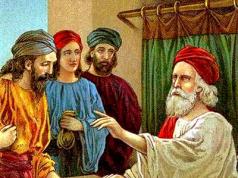Mikhail Gasparov
Entertaining Greece
From the author
If you, a young reader, leaf through this book, look at the pictures, look at the table of contents, read a few pages here and there, then the first question you will ask will probably be: “Did this really happen?”
I will answer: yes and no.
It is true that there were glorious victories of the Greeks over the Persians, and then the fabulously quick conquest of the East by Alexander the Great. It is true that the Spartans were invincible warriors, and the Athenians were better than others at building marble temples and composing tragedies for the theater. It is true that the word “philosophy” first appeared in the Greek language and that in the Library of Alexandria they studied almost all the same sciences that we study.
But around these events there were so many oracle predictions that came true; that all the heroes were heroes without fear and reproach, and the villains were villains to the depths of their black souls; that all the speeches that were said at the same time were so smart, brief and coherent; that all the wonders of earthly nature and human customs that the ancient Greeks heard about were really like this - of course, one cannot vouch for this. There's a lot of fiction here.
Whose idea is this?
The Greek people themselves invented this. This is how it always happens: when some interesting event happens, news about it is passed on from mouth to mouth, acquiring new and new picturesque details, and in the end the facts are so closely intertwined with the legends that the learned historian has to work hard to separate one from the other. another.
How historians reconstruct the actual appearance of events from contradictory stories about them - this could be written very interestingly, but this would be a completely different book. Our book is about how the ancient Greeks themselves remembered their past. Is it possible to judge a person by what he says about himself? It’s possible: even when he composes, we see what he is and what he would like to be. This is how you can judge an entire ancient culture by its stories about itself.
Everything that now goes without saying for us was once discovered for the first time. And the fact that one must obey the law; and the fact that parallel lines do not intersect anywhere; and the fact that the beating of the pulse in a person comes from the heart; and the fact that the thought of a thing can say more about it than the look at this thing; and the fact that interesting stories can be played out in faces and then it is called drama. Such discoveries were made separately in Babylon, and in India, and in China, and in Greece. But our own civilization, the modern European one, developed mainly on the basis of the ancient Greek (and the ancient Roman one that replaced it). Therefore, ancient Greek discoveries are closer to us than any others.
From century to century, almost the same definitions that were once given by Euclid were rewritten in mathematics textbooks; and poets and artists mentioned and depicted Zeus and Apollo, Hercules and Achilles, Homer and Anacreon, Pericles and Alexander the Great, firmly knowing that the reader and viewer would immediately recognize these images. Therefore, getting to know ancient Greek culture better means better understanding Shakespeare, Raphael, and Pushkin. And ultimately - themselves. Because it is impossible to answer the question: “Who are we?” without answering the question: “Where did we come from?”
However, I’m getting ahead of myself. Because “know yourself” is also one of the testaments of ancient Greek civilization, and you will encounter it more than once in this book. I wish you success!
Part one
Greece becomes Greece
or Before the law there was a legend
There is a tribe of people
There is a tribe of gods
The breath in us is from one mother,
But we have been given different powers:
Man is nothing
And the copper sky is an unshakable abode
Forever and ever.
But there is something
Raising us to the celestial level, -
Be it a powerful spirit,
Be it the force of nature, -
Although we do not know to what limit
Our path is charted by day and night by Fate.
In the beginning there was a fairy tale
Historical science begins with chronology. This may be the most boring part of the story, but it is also the most necessary. If you don’t know what happened in the past before and what happened next, then all other knowledge loses all meaning.
The Greeks understood this and memorized chronology diligently. On the island of Paros, the effort went so far that a large chronological table of Greek history was carved in marble and displayed in the square for passers-by to look at and enlighten. This table has been preserved. But it looks, to modern eyes, a little strange. Here is its beginning with minor abbreviations.
Year 1582 BC King Kekrop reigns in Athens.
Year 1529. The Great Flood, from which Deucalion and Pyrrha escaped.
The year is 1519. King Cadmus, the founder of Cadmeia, came to Thebes from Phenicia and taught the Greeks writing.
Year 1432. King Minos, son of Zeus, reigned in Crete, and the Phrygian dwarfs taught the Greeks how to forge iron.
Year 1409. The goddess Demeter came to Athens and taught the Greeks about agriculture.
Year 1300. Hercules, having cleansed the Augean stables and defeated King Augeas, established the Olympic Games.
Year 1260. Theseus, having killed the Minotaur, freed Athens from tribute, gave them laws and established the Isthmian Games.
Year 1251. Campaign of the Seven against Thebes, and at the same time the Nemean Games were established.
Year 1202. Orestes, son of Agamemnon, avenging his father, kills his mother, but is acquitted by the court of the Areopagus.
Year 1128. Relocation of the Dorians led by the kings of the Heraclides to the Peloponnese.
Year 1085. Death of Codrus, king of Athens, in the war with the Dorians. The end of royal power in Athens.
Year 937. Heyday of the poet Hesiod.
Year 907. The rise of the poet Homer.
Year 895. The Argive king Fidon introduced precise measures, scales and money into use...
You say: “Is this history? This is a fairytale! It’s like compiling a table on the chronology of Kievan Rus and including dates in it: then Ilya Muromets killed the Nightingale the Robber, and then Ruslan killed Chernomor.”
A Greek, hearing such words, would be offended. Perhaps he himself is from a noble family, which traces his origin to one of the mythological heroes mentioned here. The Spartan king Leonidas, the hero of Thermopylae, considered himself the great-great-(repeat this “great” 20 times!) -great-grandson of Hercules. The Greeks considered the lifespan of a human being to be 70 years; the best period for the birth of a son was the middle of life, 35 years. Leonidas died in 480 BC. Count from this date 23 times 35 years (the life of Leonidas and 22 generations of his ancestors) and you will find yourself in 1285 BC, exactly at the time in which the Parian Table settles Hercules. How can one not believe such a chronology?
ISBN: 978-5-9582-0038-2
format: 84x108/16
320 pp.
Abstract: Ancient Greek myths have been retold in Russian more than once. But the proposed retelling differs from the already existing ones in that, almost for the first time, it presents Greek mythology not as a collection of heterogeneous heroic stories, but as a single story of relations between gods and people, the beginning of which is the creation of the world and people, the culmination is the victory of the gods with the help of people over the dark ones forces of nature (“gigantomachy”) and the denouement - the self-destruction of human heroes, no longer needed by the gods, in two world wars, by the standards of that time: the Theban and Trojan.
The book is not overloaded with names and details, but at the same time freely uses entertaining little-known variants of mythological plots.



MYTHS OF THE STARRY SKY
In addition to the astronomy of the Alexandrian observatories, there was also the astronomy of the people and poets. It turned out to be much more tenacious: the theory of spheres or epicycles is now remembered only by historians of science, and the names of the celestial constellations are still in use the same as those used by the Greeks. However, not everyone remembers the myths associated with these names. Let's remind them.
The main attention of observers was attracted by the narrow strip of those constellations in which only five planets, the Moon and the Sun could be seen. This band that hugs the sky (zodiac - “animal circle”) was divided into twelve constellations. Aries is the golden ram behind whose fleece the Argonauts sailed to Colchis. Taurus is the bull that Zeus transformed into to kidnap his beloved princess Europa. Twins - Dioscuri Castor and Polydeuces, sons of Queen Leda, one is immortal, from Zeus, the other is mortal, from an earthly father, but they loved each other so much that the gods did not want to separate them. Cancer is the one that grabbed the leg of Hercules when he fought with the Lernaean Hydra (the constellation Hydra is located right there, nearby). The lion is, of course, the Nemean lion, the victim of the first labor of Hercules. Virgo - the goddess Truth, the last of the gods to leave the sinful earth; next to her are Libra - a symbol of her justice. Scorpio is the monster who killed Orion, who runs away from him at the opposite end of the sky; we will talk about them further. Sagittarius, Capricorn, Aquarius and Pisces - the Greeks could not tell anything intelligible about these constellations; at most, they assumed that Aquarius was perhaps Ganymede, the cup-bearer of Zeus, or Deucalion, the hero of the flood.
Higher above the horizon, the constellations were located in five mythological groups. The myth of Perseus was played out over Pisces and Aries. Here at the very heights were King Cepheus and Queen Cassiopeia, who boasted that she was more beautiful than the sea nymphs. For this, Poseidon sent the monstrous Whale, which is visible above the horizon, to their country. Keith had to sacrifice the princess Andromeda - she was prostrate in the gap. But she was saved by the hero Perseus in winged sandals - here he flies up from the direction of Taurus.
Orion is raging near Taurus and Gemini. This is the wild hunter, the son of the Earth; he tried to attack the goddess Artemis herself, but she called out to Scorpio, and he stung Orion in the heel. Both Scorpio and Orion with his two hunting Dogs, Greater and Lesser, were ascended to heaven. Orion did not calm down here either: he pursues the daughters of Atlas, the nymphs of the Pleiades and the nymphs of the Hyades, who once nurtured the god Dionysus; the nymphs hide from him in the constellation Taurus. The constellation Auriga looks down on these outrages from above - a mysterious figure with the bright star Capella on his shoulder. “Capella” means “goat”: this is the goat whose milk fed baby Zeus and whose horn was later depicted as a cornucopia.
Above Virgo and Libra stands Bootes (Boot), also known as the Bear Watchman (Arcturus), with his Hounds. If he is Bootes, then he grazes seven oxen - the seven stars of the Big Dipper. If he is the Bear Watchman, then his story is more dramatic. Zeus fell in love with the nymph Callisto, Artemis's companion, and she bore him a son, Arkad. Outraged, Artemis turned Callisto into a bear. Arkad grew up, became a hunter, met his mother in the form of a bear while hunting, did not recognize her, chased after her, and at the last moment Zeus saved them from crime by turning them into constellations. On one side of Bootes-Arcturus is the Northern Crown, given by the god Dionysus to his bride Princess Ariadne, the savior of Theseus in the Labyrinth; on the other hand, the Hair of Ariadne, renamed by the helpful Alexandrian astronomers as the Hair of Berenice. When King Ptolemy III went to war, his wife Berenice cut off her hair and brought it to the temple as a sacrifice for the safe return of her husband; the next day they announced to her that her sacrifice had been accepted and her hair was already among the stars.
Above Scorpio in the sky there are two sons of God, ranked among the gods. This is Ophiuchus with two snakes in outstretched hands - they saw him as Asclepius, the son of Apollo, the great healer, struck down by the lightning of Zeus because he dared to heal people not only from illnesses, but also from death. And this is Hercules, rushing with his club to the heavenly pole: there above him is his enemy, the Dragon, guarding the golden apple tree of the Hesperides, the fruits of which Hercules picked in his penultimate labor.
From Sagittarius to Pisces, three Apollo and two Zeus constellations stretch across the sky. Zeus was the winged horse Pegasus and the sacred bird of the king of the gods, the Eagle, which once pecked Prometheus; This Eagle is pierced by an Arrow sent by Hercules. Apollo's were his sacred bird, the Swan, and next to her, Lyra and Dolphin, a memory of the salvation of his singer Arion.
Finally, the Milky Way, which crosses the entire sky, also had its own mythological explanation. Although Hercules was the son of Zeus, his mother was mortal, and in order to subsequently become a god, he certainly had to suck the milk of the goddess Hera, the wife of Zeus, and Hera hated Hercules. The cunning Hermes took advantage of the time when Hera was sleeping and put baby Hercules to her chest. The awakened Hera angrily pushed the baby away, her milk splashed out and formed the Milky Way.
Such was this celestial mythology. For astronomers, it replaced the coordinate grid. The stars were called as follows: “on the right leg of Cepheus, on the left leg of Cepheus, on his belt on the right, above his right shoulder, above his right elbow, on his chest, on his left hand and three on the tiara, northern, middle and southern, and in total Cepheus has ten stars." And then for each of them the latitude and longitude were calculated on the vault of heaven.







This is the last book by the famous scientist, writer, antique scholar and literary critic Mikhail Leonovich Gasparov. After all, what are Greek myths? This is often understood simply as fairy tales from ancient Greece. But a myth is not just any fairy tale: it is a fairy tale that was once believed. They believed that the world was ruled by gods, that great heroes walked the earth and fought with monsters and each other, showing miracles of valor and honor. Ancient Greek myths have been retold in Russian more than once. But the proposed retelling differs from the already existing ones in that, almost for the first time, it presents Greek mythology not as a collection of heterogeneous heroic stories, but as a single story of relations between gods and people, the beginning of which is the creation of the world and people, the culmination is the victory of the gods with the help of people over the dark ones forces of nature ("gigantomachy") and the denouement - the self-destruction of human heroes, no longer needed by the gods, in two world wars, by the standards of that time: the Theban and Trojan. To complete the picture, the Appendix contains a never-before-published story by M. L. Gasparov about Peleus and two tales: about Hercules and about Cupid and Psyche. "Peleus's Tale" is interesting because many well-known mythological events, such as the Calydonian hunt, the campaign of the Argonauts, the prehistory and course of the Trojan War itself, are presented in it from the point of view of an eyewitness and their direct participant, whose assessments do not always coincide with generally accepted ones. And in “The Tale of Hercules” and “The Tale of Cupid and Psyche,” plots that are quite familiar to us are retold in the style of a Russian folk tale, which is unusual for this genre, which creates a rather unexpected effect. About all this and more in the book Entertaining mythology: Tales of Ancient Greece (Mikhail Gasparov)








